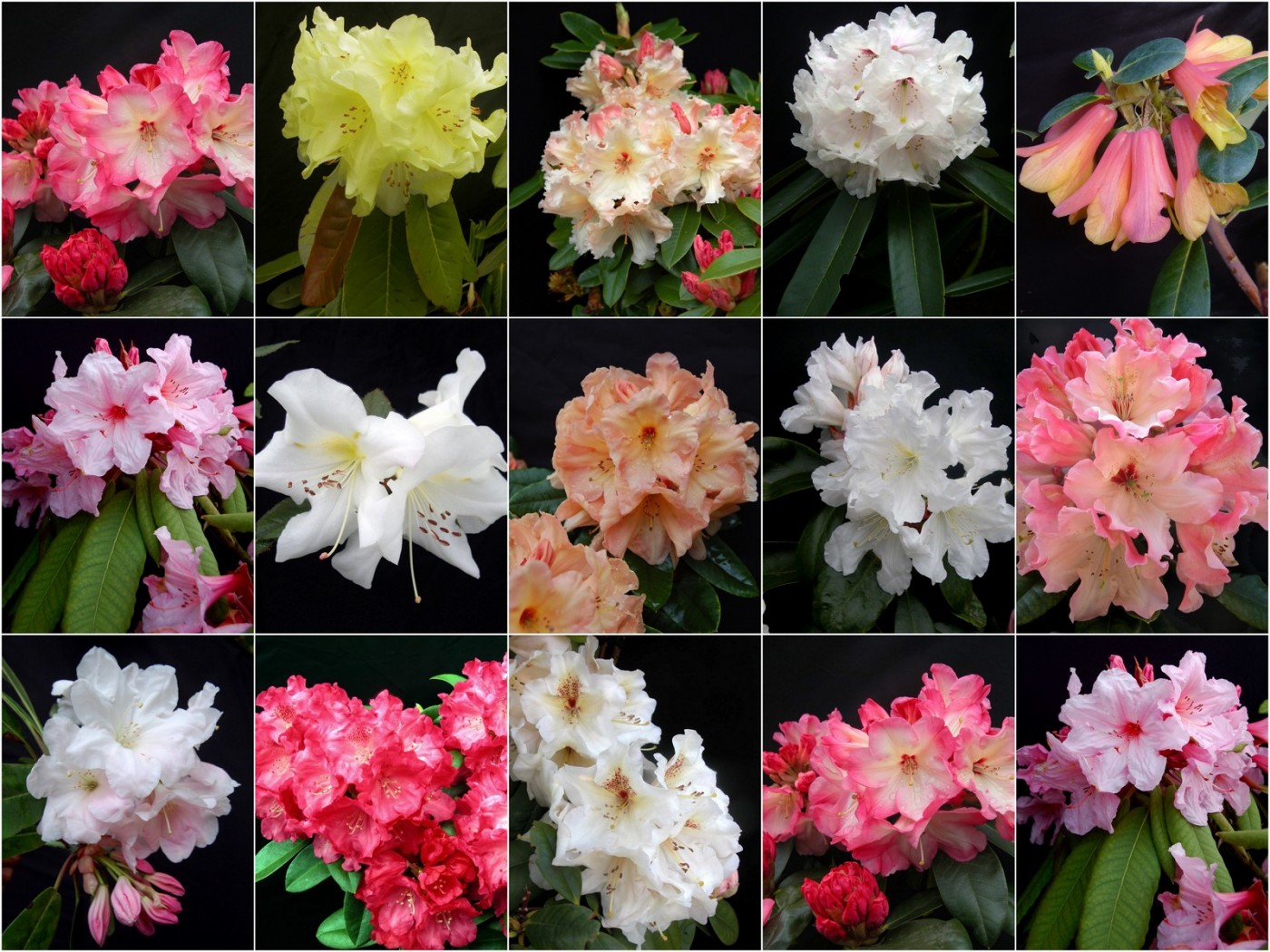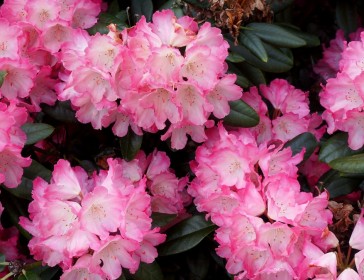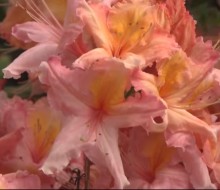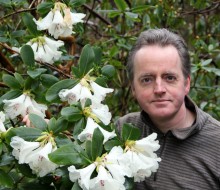

With 900 Species and almost 30,000 named cultivars, identifying rhododendrons is a skilled job which only a handful of people are qualified to do.
Kenneth Cox has a lifetime's experience in identifying and labelling plants in collections and has done this in many parts of the world including Canada, USA, Scandinavia, France, Australia, Germany and all over the UK and Ireland.
Kenneth Cox has written 6 books on Rhododendrons and Azaleas and is currently working on a definitive book on woodland gardening.
There are a number of other consultants who offer to identify rhododendrons by taking samples and looking them up in books. I simply dont believe that this can be done. Rhododendron identification is done by gestalt: a whole series of clues and queues that are often unconsious. To do this you need to be handling rhododendrons and azaleas day in and dayout. And you never stop learning. Kenneth Cox can do all the required identifcation on the ground and immediately.
How can you get your rhododendrons identified by Kenneth Cox
1. For a limited number (maximum 10 items), e mail digital photographs to Glendoick taken in flower. The photos should be taken in bright light but not sun, so an overcast day is ideal. Try to show both the flowers and foliage. Provide any other details known: where and when bought/planted if known.
Example of a good photograph for identification purposes where flowers and foliage are clearly shown R. Fantastica, below

Example of a poor photograph for identification (below): no foliage, too close.

2. Bring in samples to Glendoick. (by appointment). These should be numbered so that they can be matched with the bushes at home. I can e mail the identifications back by number.
3. Consultancy Site visit. Changed at £700 per day. Travel extra at cost. Further details on the Kenneth Cox Garden Consultancy pages.
Ideally Kenneth Cox should visit when plants are in flower but he can identify rhododendron species and hybrids out of flower. With azaleas, this is not possible as they tend to lack distinguishing features when not in flower.
To get the best out of these visits, preparation work would be to number beds and areas for easy reference, or number the bushes which require to be identified. Kenneth Cox can write and tie on labels as he goes round but these need to be then created as permanent labels, as the temporary ones will only last a few months.
Find out if possible when the garden was planted and which nurseries were used to obtain material. This helps narrow down the options.
Labelling Collections of Rhododendrons
Many fine woodland gardens have been reduced in value by inadequate labelling or record keeping. Woodland gardens are long lived and are often passed through generations of owners and gardeners. And each generation always wishes to have had better records and labelling… and all too often the person with the knowledge never quite gets round to writing it down. Technology in the form so portable devices most of which now have GPS, means that we can more easily map and record what we have, while out in the garden. It is useful to name or number the different sections of your garden. Electronic mapping allows layers and overlays so that you can subtract or add data: one layer might be contours, another tree cover, another shrubs and other irrigation and drains and so on.
For records, some still like card indexes, though most now use a computer database or spreadsheet program or dedicated plant record software such as IrisBG, BGbase or Demeter (obtainable free for UK National Collection holders). At Glendoick we use an MS access database to record all our plants. It contains names, dates of accession, botanical information and planting locations and we draw rough maps on paper. You might want to collate detailed data on your plants, including wild collection data (such as collectors number, date collected in the field, location, elevation, field notes), acquisition date, in what form (seed, cutting, plant), source of material (nursery, friend, botanic garden), age and size planted, dates of flowering time and comments on performance and garden value. Accession numbers are considered essential for botanic gardens but for a nursery like ours with constant propagation, we don’t bother with them.
Using GPS handheld devices would allow reasonably accurate mapping to made by taking positional readings in each area of the garden and recording what is planted there. If you want to, you can then allow garden visitors to access these records on their own devices. There is no limit to the interactive potential if you are prepared to invest time and money in this.
Until recently most plant collectors recorded their collections under numbers with field note which allowed plants to be traced back to their wild origins. KW numbers refer to Frank Kingdon Ward, FAR to Reginald Farrer and so on. Recent legislation surrounding the Convention on Biodiversity will restrict plant collecting and is likely to reduce the use of collector’s numbers.
The three best examples of private (as opposed to botanic garden) record keeping I have seen outside the major botanic gardens are Philip de Spoelberch’s collections at Herkenrod in Belgium, Lord Howick's collection in Northumberland and the late James Russell’s plantings at Ray Wood, Castle Howard, Yorkshire. All of these gardeners believe passionately in the value of accurate and detailed records. But this takes significant investment in time and money, something not all of us are willing or able to do.
Labels
Ideally a label should be easily seen but not obtrusive, legible, last a long time and fixed so that it is not easily broken off by wind or stolen. Most of us are still seeking for that ideal label. The longest lasting labels, which you still find after 100 years in older gardens are embossed metal labels onto lead or aluminium. Some collections attach embossed numbered labels to plants and then reference these to a separate list. Plastic labels seldom last more than 5 years before becoming brittle. We tend to find that aluminium labels written on with a soft pencil tend to last well. Up to 20 years or more in ideal conditions. Beware of label death, where a branch or stem is girdled metal, by the failure to loosen a label as the plant grows. Dymo labels are surprisingly long lasting, as long as you can find something durable to stick them onto. Another long lasting material is a label with a black skin, white beneath where the name is scratched into the surface. We found that the labels became brittle but the names remained legible, if sometimes tricky to read due to scratch writing. Zinc labels can be etched with ink which contains hydrochloric acid. We found that these labels tarnished and the etching did not remain all that clear in the long term. Most botanic gardens use engraved labelled on UV stabilised plastic or modified acrylic laminate. These are long lasting but expensive typically £2-3 ($3-4) each.
 Born in 1964 into a family of renowned plantsmen, Kenneth Cox is grandson of planthunter, writer and nurseryman Euan Cox and son of Peter Cox VMH. The three generations were and are considered the world's leading experts on rhododendrons.
Born in 1964 into a family of renowned plantsmen, Kenneth Cox is grandson of planthunter, writer and nurseryman Euan Cox and son of Peter Cox VMH. The three generations were and are considered the world's leading experts on rhododendrons.
Kenneth is managing director of the family firm Glendoick Gardens Ltd in Scotland, a garden centre and mail order nursery specialising in Rhododendrons, Azaleas, Ericaceous plants, Meconopsis, Primula and other plants collected by the Cox family around the world.
Kenneth is author of numerous books on rhododendrons, Scottish Gardening and Plant Hunting. (see listing below).
He has served on the National Trust for Scotland advisory panel on Gardens and Planned Landscapes and advises the National Trust on several of their woodland gardens. He designs and advises on the restoration of woodland gardens and rhododendron gardens in the UK and elsewhere. He is patron of the Emu Valley Rhododendron Garden in Tasmania, Australia.
Ken has carved out his particular niche in the world of plant-hunting in leading 9 expeditions to South and South-East Tibet and Arunachal Pradesh, India, 1995-to the present.
Bodnant Gardens, (Wales) (2016)
Woburn Abbey, (England) (2015)
Mount Stewart, (N Ireland) (2013-15)
Aldourie Castle, (Scotland) (2016)
Bolfracks Garden, (Scotland) (2011-12)
Soferio (Sweden) (2013)
Bremen Rhododendronpark and Rhododendron Genbank Project (2013)
Trevarez (Bretagne, France) (2013)